
Related
On the last day of Cindy Sheehan’s vigil outside President Bush’s estate in Crawford, we look back at the day her son, Casey, died. We speak with a U.S. army soldier who was wounded on the same day Casey was killed, an independent journalist who visited the area shortly afterwards and Cindy Sheehan. [includes rush transcript]
President Bush’s vacation is officially over this week, as he returns to Washington. And there is little doubt that his time these past weeks at his Crawford, Texas estate will forever be remembered as the summer of Camp Casey, named for 24 year-old Casey Sheehan who was killed in Baghdad’s Sadr city on April 4, 2004. By now, you’d have to be living in a news vacuum to not know the name Cindy Sheehan, Casey’s mother, who set up a lawn chair down the road from Bush’s property at the beginning of the president’s 5 week vacation to demand that she be allowed to speak directly to Bush. What grew out of that simple act was an antiwar tent city of sorts that has seen a stream of visitors. Among them: families with soldiers deployed in Iraq or who had their loved ones killed there, veterans of the current Iraq war, musicians Joan Baez and Steve Earle, actors Martin Sheen, Margot Kidder and Native activist and actor Russel Means. Scores of activists and other concerned or inspired people have joined the camp at various points. There have been literally hundreds of journalists in Crawford; among them, the celebrities from the White House press corps. There have also been counter-demonstrators and prowar families.
Over these weeks, Cindy Sheehan’s vigil has served as an igniting spark for the antiwar movement and has provided a gateway into a broader discussion across the US on the occupation of Iraq. Well, as Cindy Sheehan prepares to leave Camp Casey in Crawford, we wanted to focus in on the story of her son and his death more than a year ago in Baghdad’s Sadr city. In fact, Casey Sheehan was killed on Sunday, April 4, 2004 and that Monday on Democracy Now!, we reported on the battle in which he was killed.
- Democracy Now broadcast, April 5, 2004.
President Bush and his supporters have sought to portray the resistance in Iraq as foreign fighters, terrorists, Saddam loyalists and al Qaeda. But the death of Casey Sheehan gives lie to that line.
- Cindy Sheehan, talking recently about how her son died.
In a moment, we are going to be joined by a U.S. soldier who was in Sadr City that same day as Casey Sheehan. He didn’t die but he was severely wounded that day and is now paralyzed from the chest down. But first, here is what President Bush had to say the first time he was asked publicly about the uprising in Sadr City that took the life of Casey Sheehan and 9 other soldiers.
- President Bush, April 5, 2004.
At the time Casey Sheehan and his fellow soldiers were killed in Sadr City, independent journalist and author Rahul Mahajan was in Iraq and reported on Democracy Now! about his time in Sadr City that weekend talking with US soldiers.
- Rahul Mahajan, speaking on Democracy Now!, April 13, 2004.
U.S. Army Specialist Tomas Young fought in the same division as Casey Sheehan and was shot during the massive uprising in Sadr City on April 4th 2004–The same date and place that Cindy Sheehan’s son Casey was killed. Young is now paralyzed from the chest down. He recently left Camp Casey where he also demanded to speak with President Bush.
- Tomas Young, U.S. Army Specialist and Iraq War Veteran.
- Rahul Mahajan, independent journalist and author of a number of books including “Full Spectrum Dominance: U.S. Power in Iraq and Beyond.” He runs a blog at empirenotes.org.
- Cindy Sheehan, mother of soldier killed in Iraq and founder of Camp Casey in honor of her son Casey Sheehan who was killed in Iraq in April, 2004. She is also a co-founder of Gold Star Families for Peace.
- Photographs of Camp Casey by Kim Terpening can be found at AlaskaGyrl.blogspot.com
Transcript
AMY GOODMAN: Casey Sheehan was killed on Sunday, April 4, 2004, and that Monday on Democracy Now!, we reported on the battle in which he was killed.
AMY GOODMAN: [April 5, 2004] The U.S. occupation entered a new phase Sunday as Shiite Iraqis staged an armed uprising against the occupying forces in four cities. A total of at least 50 Iraqis and 10 U.S. troops died on Sunday. Hundreds were injured. The U.S.-led occupying forces lost control of at least one city. Police stations were burned in four others. The resistance continued early today in Basra, where dozens of Shiites occupied the governor’s office. The young Shiite cleric Moqtada al-Sadr called for the uprising after the U.S. shut down one of his newspapers and arrested one of his top aides. In a statement, Sadr said, “Terrorize your enemy. God will reward you well for what pleases him. It is not possible to remain silent in front of their abuse.”
AMY GOODMAN: That was our report on April 5, 2004. President Bush and his supporters have sought to portray the resistance in Iraq as foreign fighters, terrorists, Saddam loyalists and al Qaeda. But the death of Casey Sheehan gives lie to the line. This is Cindy Sheehan talking recently about how her son died.
CINDY SHEEHAN: Casey was such a gentle, kind, loving person. He never even got in one fistfight his whole life. Nobody even hated him enough to punch him, let alone kill him. And that’s what George Bush did. He put our kids in another person’s country, and Casey was killed by insurgents. He wasn’t killed by terrorists. He was killed by Shiite militia who wanted — they wanted him out of the country. When Casey was told that he was going to be welcomed with chocolates and flowers as a liberator, well, the people of Iraq saw it differently. They saw him as an occupier.
AMY GOODMAN: Cindy Sheehan. In a moment, we’ll be joined by Cindy Sheehan and also by the U.S. soldier in Sadr City the same day that Casey Sheehan was killed. But Tomas Young didn’t die. He was severely wounded that day and is now paralyzed from the chest down. First, though, President Bush, what he had to say the first time he was asked publicly about the uprising in Sadr City that took the life of Casey Sheehan and nine other soldiers.
PRESIDENT GEORGE W. BUSH: The message to the Iraqi citizens is they don’t have to fear that America will turn and run. And that’s an important message for them to hear. They think we’re not sincere about staying the course. Many people will not continue to take a risk toward — take the risk toward freedom and democracy.
AMY GOODMAN: That was President Bush, April 5, 2004. At the time Casey Sheehan and his fellow soldiers were killed in Sadr City on April 4, the day before, independent journalist and author, Rahul Mahajan, was in Iraq and reported on Democracy Now! about his time in Sadr City that weekend, talking with U.S. soldiers. This is what he had to say.
RAHUL MAHAJAN: Initially I did, when I was in Sadr City a couple of days after the outbreak of violence there, and I talked to some young men who were posted there. They had only been in Iraq three weeks, and so they were more friendly and easier to approach. There was one we tried to talk to who simply kind of waved us on, the way that most troops will do if they’ve been in the country for a long time. They get extremely wary and nervous. But these guys talked to us. They were perfectly nice. They were very, very ignorant of what was going on in Iraq. They were there in Sadr City because of clashes with al-Sadr’s Mahdi army. And I asked them, “So what do you think about this stuff with al-Sadr? What do you think about the Mahdi army?” And they said, “What? Who is that? Who are they?” In fact, one of them was very curious and came up and asked us several questions, trying to figure out who these people were. They were thrown in here. They don’t know any Arabic. They don’t even know how to say, “Please get away from the tank,” in a respectful way, and they’re sent over here to kill people and die. And it is a shame.
AMY GOODMAN: That was independent reporter, Rahul Mahajan, right after the Sadr City battle. When we come back from break, we’ll be joined by one of the soldiers who was there and, unlike Casey Sheehan, survived, though he was paralyzed. His name is U.S. Army Specialist Tomas Young. We’ll also be joined by Rahul Mahajan, as well as Cindy Sheehan.
[break]
AMY GOODMAN: We turn now to Tomas Young, the young soldier, U.S. Army Specialist, who fought in the same division as Casey Sheehan and was shot during the massive uprising in Sadr City on April 4, 2004, the same day and place that Cindy Sheehan’s son, Casey, was killed. Tomas Young now paralyzed from the chest down, he recently visited Camp Casey where he, too, demanded to speak with the President. Joining us on the line from Austin, welcome to Democracy Now!
TOMAS YOUNG: Thank you.
AMY GOODMAN: It’s good to have you with us.
TOMAS YOUNG: It’s good to be here.
AMY GOODMAN: Can you talk about that day, April 4, 2004?
TOMAS YOUNG: Yeah. I was — it started for me, I was sitting in the back of my vehicle, just listening to some music, and my squad leader came up and told me to get my gear and get in the back of the truck. We were going out on a mission, which was interesting for me to start with because I had recently switched positions in the company to be more of a company clerk kind of thing, because during my — I had previously enlisted at the age of 17, and that was the kind of job that I had trained for. So — and I was an infantry soldier the second go-round, so I had kind of put myself in the more administrative position.
AMY GOODMAN: When had you arrived in Baghdad?
TOMAS YOUNG: What’s that?
AMY GOODMAN: When did you arrive in Iraq?
TOMAS YOUNG: Four days prior to this being put on this mission.
AMY GOODMAN: And so, you were sent to Sadr City. What did you do?
TOMAS YOUNG: No, our — that was — Sadr City was where we were — that was our camp. We weren’t sent there. That was where the division commander volunteered us for that particular part of the city of Baghdad.
AMY GOODMAN: And so, what happened that day, April 4?
TOMAS YOUNG: I was put onto a truck with 24 other soldiers, when I should have only been put with 17 for the maximum capacity of the truck. So, we were all pretty crammed in there pretty tight and the truck had no canvas top to it, so it was just open, and nor did it have any armor on the sides. And we got in the truck, and we were going out to provide security for some downed soldiers, to provide security for a rescue mission for some downed soldiers in a part of the city. So, we went out there. We got — went out through a safe route and we got to the mission site, and everything went fine. We loaded back up in the truck, and instead of going back to the base the way we had come, we decided to go directly through the heart of Sadr City.
AMY GOODMAN: And what happened?
TOMAS YOUNG: As we were driving through, I guess, their Main Street, as it would be, there were Iraqi insurgents on the tops — on the rooftops of all of the buildings. And to them, I mean, it must just look like fish in a barrel because we were all crammed in so tight. None of us could really get any — any arm — any space for our arms and our weapon to point out the truck to look at anybody, and they didn’t really particularly have to aim. They could just hit anything they shot at, and the truck was driving very slow. I — we were told to shoot at anything we saw that looked like a threat. And all I could see were women and children. I could differentiate women and children from, you know, angry militant men that were — had guns. So, I didn’t shoot. There were other guys who, you know, because they were scared, they couldn’t make that distinction, so they were shooting. And I would see occasions and instances where men with guns would go down and I would see, okay, we’re hitting some, but I — I’m sure women and children didn’t get hit. I’m not saying that. I just — I couldn’t see anybody, so I’m sure — I don’t know.
AMY GOODMAN: Was your vehicle armored?
TOMAS YOUNG: No. My vehicle was not. My vehicle that I drove or —
AMY GOODMAN: That you were in.
TOMAS YOUNG: That I was in? The truck. No. We were in an unarmored vehicle that — as I said, the vehicle had no armor, and it had no top to the — there was no top. So, they could just — it was open.
AMY GOODMAN: Did you understand why you were there, Tomas Young?
TOMAS YOUNG: Why I was in Iraq?
AMY GOODMAN: Yeah. Why were you in Sadr City that day, why you were driving there, what was happening?
TOMAS YOUNG: I didn’t understand what was going on, why we were going through to the middle of the city.
AMY GOODMAN: I wanted to bring Rahul Mahajan in right now, independent journalist who was in Iraq at that time. Rahul Mahajan, what was your understanding of what was happening?
RAHUL MAHAJAN: Well, you know, on March 29, the Sadrist newspaper al-Hawza was closed. And what transpired later is that around that time also, the C.P.A. signed off on an order which it had been holding for almost a year to go to arrest Moqtada al-Sadr in connection with the murder of an exiled cleric, Abdel Majid al-Khoei. And then, in response to that, there were a number of protests by Sadrists. I talked to people — to Sadrist people in Al-Shoala, Kadamiya and in Sadr City, three mostly Shiite areas of Baghdad, and I got pretty much the same story from all of them. It’s hard to verify, but basically they said, after the closing of the newspaper, there were lots of peaceful protests. I’m not saying that they were unarmed, because nobody in Iraq is really — really goes unarmed, but they were peaceful. The crowds were not firing, and they were more or less attacked by U.S. forces. In one in Baghdad, a protester was crushed under a tank. In several others, people were fired on by U.S. forces, and over the period from March 29 through April 3 or 4, there was an escalating dynamic of violence, and according to the Sadrists, really pushed by U.S. forces, and then it exploded in violence on April 4 in Sadr City, and all through much of Southern Iraq as well.
AMY GOODMAN: Rahul Mahajan, who was in Iraq at that time, and then moved in and talked to U.S. soldiers. It’s interesting to have you here, Rahul Mahajan, as well as one of the soldiers who was there, U.S. Army Specialist, Tomas Young. Do you have a question for Tomas Young, Rahul?
RAHUL MAHAJAN: Well, yeah. I mean, it’s remarkable, I think. I was there only three days later in Sadr City talking to and interviewing the very people who were involved in these clashes, and it certainly — I do wonder several things. One of them being, really, what was the level of education about the specifics given to the soldiers? What were you told, Tomas, for example, about who you were fighting and why you were fighting them, and what they were all about before you were sent in that open, unarmored truck?
TOMAS YOUNG: I — me particularly, in particular, I was told nothing about who we were fighting or what was going on. The only thing I was told was that we were going to provide security for a rescue mission for two soldiers that were down from another company, and it was to my understanding that once that was done, for my particular truck, we were going back to the base.
RAHUL MAHAJAN: Well, of course when you go on a rescue mission —
TOMAS YOUNG: I didn’t know anything about why we were going towards the center of the city, or I had no level of education as to what was going on that particular day or what was happening.
RAHUL MAHAJAN: Well, of course, when you are going on a rescue mission in an area where there’s active fighting, there’s a good chance that you will be fighting, as well. Another thing I wonder is that one gets a general impression that U.S. soldiers are told basically, “These are a bunch of bad guys. These are a bunch of terrorists,” given the impression that they are just sort of addicted to mindless violence, and that’s why you have to go and fight them. Was that the sort of general impression you had or was there a feeling that there were some actual understandable reasons why, for example, these people might be fighting you?
TOMAS YOUNG: For me — I’m sorry, could you repeat that again?
RAHUL MAHAJAN: Did you get — were you sort of given the impression that these people you might be fighting were basically mindless terrorists addicted to violence, or did you have a sense there might actually be political reasons behind their attacking U.S. forces?
TOMAS YOUNG: Well for my — me, in particular, my understanding was that that was what I understood to be happening, was they had political reasons for wanting Americans out and all of that, again to be fighting us, but from what the battalion level and all of the higher-ups were trying to tell us, that they were just mindless terrorists who, yeah, they wanted to come over and destroy the American way of life and that we were going to defend freedom and, you know, that was definitely the rah-rah, gung ho kind of attitude they were trying to instill in us so that we could, you know, feel more comfortable with going in and, you know, I guess killing them.
AMY GOODMAN: Tomas Young, why did you go to Camp Casey? You were on your honeymoon. You just got married, but you chose to go there this weekend.
TOMAS YOUNG: The reason I went to Camp Casey is because I had been watching the news, and I saw that President Bush wouldn’t meet with Cindy because — his reasoning was that he had already met with her, and I got to thinking, well, my life has been severely impacted by my volunteering to fight in this war, this, I guess, unjust war. What reasoning would he have to meet with me, because he’s never given me that honor? And unlike Cindy, I’m not going to wait for him to meet with me. I’m not going to follow his motor — I’m not going to follow him back to Washington. If he wants to meet with me, he can find me, and likewise, his reasoning for not meeting me will find me also, because I have a TV.
AMY GOODMAN: We’re talking to U.S. Army Specialist, Tomas Young, who was paralyzed on April 4, 2004, a U.S. soldier in Sadr City, paralyzed the day that Casey Sheehan was killed. We’re also joined on the phone by Cindy Sheehan, Casey’s mother who started Camp Casey, went to Crawford on August 6 and demanded to meet with President Bush. Today, Cindy Sheehan, is your last day at what’s become known as Camp Casey. Your thoughts today, and your feelings about Tomas Young coming to the encampment to join you, another young man in your son’s division?
CINDY SHEEHAN: Well, it was an honor to meet Tomas and his wife, and I’m glad Tomas came out and shared the experience with us. I just disagree with him on one thing. It wouldn’t be an honor for him to meet George Bush. It would be an honor to George Bush if he ever met Tomas, because Tomas has more courage and integrity in his pinky than George Bush has in his entire body. And we’re — actually, our plans are now to find a piece of property right by George Bush’s ranch and put up a veteran’s rehabilitation center there. So, he — for the rest of his life, he will have to look — George Bush will have to look and see what his policies did. He will have to look at people like Tomas and know that he has devastated so many people in this country by his lies and his deceptions, and when I see people like Tomas, it just makes me resolve to fight even harder for our young people over there and for the people of Iraq and really for the people of the world. And Casey was killed in an LMTV, like Tomas was in,. They didn’t even have their armor from Kuwait yet. They didn’t have their tanks. They didn’t have their Bradleys. And they sent our children to be sacrificial lambs, to be slaughtered, you know, in the city. And it just really proves that our babies, our precious, precious children are nothing but cannon fodder to these people. I just want to encourage all of America to not give your children to these maniacs. When mothers stop allowing their children to be sacrificed for greed, that’s when the wars are going to stop.
AMY GOODMAN: What are your plans now, Cindy Sheehan, as you leave Camp Casey?
CINDY SHEEHAN: We’re getting on the bus. We’re not letting up. But now we’re going to shift part of the pressure on the Congress. You know, Congress is, as much if not more, culpable for the bloodshed in Iraq. And we’re going to keep the pressure on the President, obviously. You know, we had 1,500 people in San Diego, while he was there the other day, protesting his policies. We will keep the pressure on him, but now we’re going to go to Congress — excuse me, I don’t have a voice anymore — and we’re going to ask Congress the same questions we wanted to ask the President, but also we’re going to put on top of it, “How many more people are you willing to let die for this mistake before you call an end to it?”
AMY GOODMAN: Forty percent of Mississippi’s National Guard, thirty-five percent of Louisiana’s is in Iraq. Final comment on that. And we just have a few seconds, Cindy Sheehan.
CINDY SHEEHAN: Well, I think, of course, it’s George Bush’s policies, and not only are their personnel over there, but their equipment is over there, too, and that’s going to be devastating, more than ever for those states.
AMY GOODMAN: Cindy Sheehan, will you be at the major anti-war rally in Washington on September 24th?
CINDY SHEEHAN: Absolutely.
AMY GOODMAN: And, Tomas Young, will you be there?
TOMAS YOUNG: Yes. I’d also like to say, the reason I’m not going to follow George Bush back to Washington is I have medical appointments at my V.A. all the time, so I’m coming back. I have lots of medical reasons to stay at home.
AMY GOODMAN: Well, I want to thank you both very much for being with us, Army Specialist Tomas Young, joining us from Austin, as did Rahul Mahajan, joining us from Austin, and Cindy Sheehan, who is breaking camp today, leaving Camp Casey. They will be together again on September 24th. Special thanks to Kim Terpening, aka Alaskagyrl, for photos of Tomas Young and his wife at Camp Casey

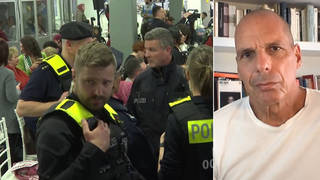
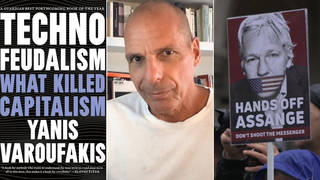
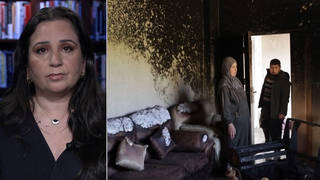
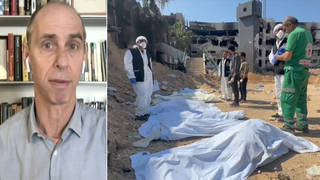





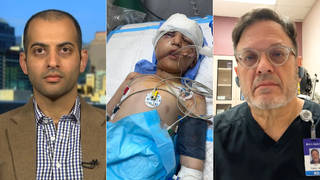
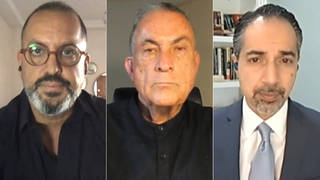
Media Options